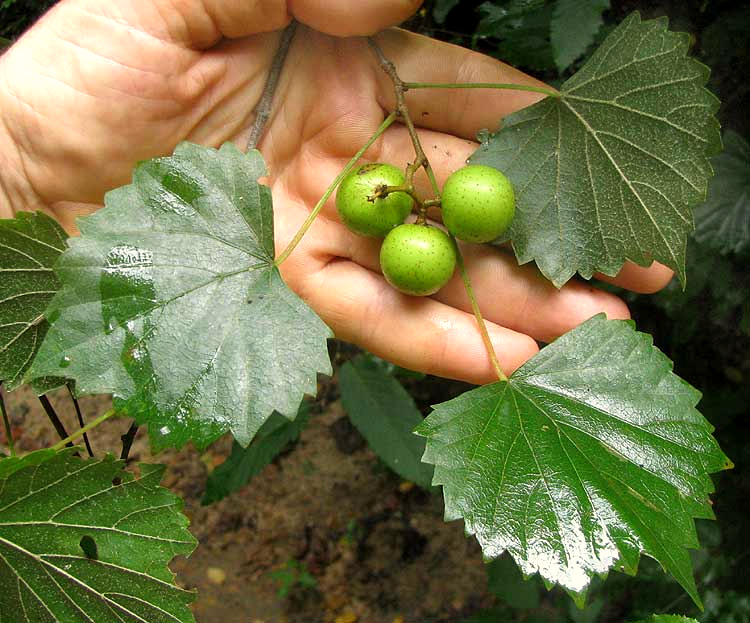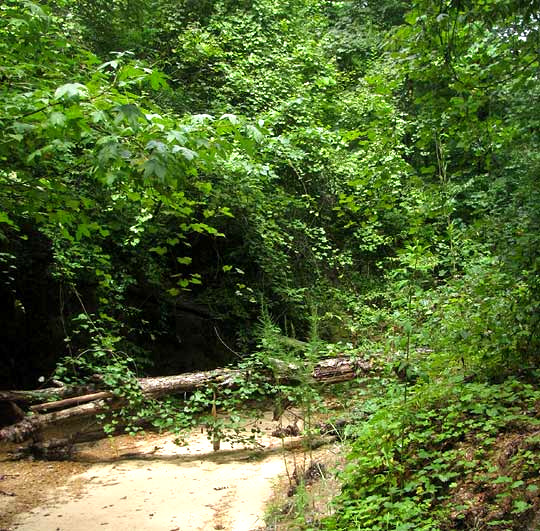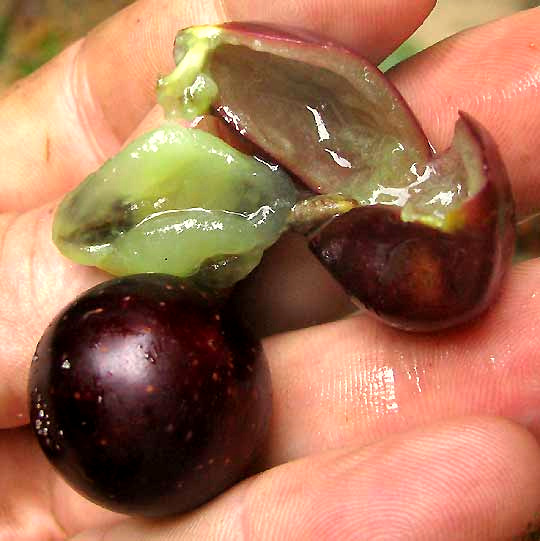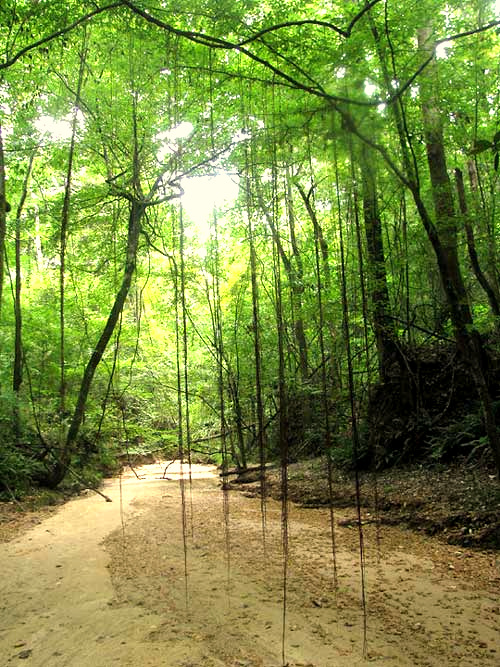Excerpts from Jim Conrad's
Naturalist Newsletter

from the July 15, 2012 Newsletter issued from the woods of the Loess Hill Region a few miles east of Natchez, Mississippi, USA
MUSCADINES IN JULY
Below you can see a picture that at first looks a bit uninteresting, but which shows some surprising details when analyzed:

That's the dry, sandy bottom of a deep ravine, or bayou as it's known here, with steep loess walls on both sides, not far downslope from my trailer. You can walk down such streambeds for miles here, hindered only by fallen trees.
Notice the green leaves occupying the picture's bottom, right. They're the same kind of leaf borne by the vine draping the tree trunk fallen across the streambed and they're the same on the vines massively covering vegetation in the background, occupying the entire upper center part of the picture. These are leaves of a woody-stemmed grapevine, and though I searched diligently among the leaves I couldn't find a single grape among all that viny foliage. However, around the bend, an otherwise undistinguished, low-hanging vine of the same kind but not nearly as robustly proliferating did bear some green, immature fruits -- and they were unusually large ones -- as shown at the top of this page.
This is the famous Muscadine, VITIS ROTUNDIFOLIA, which since the 1500s has been used for making muscadine wine. Over 300 muscadine cultivars are grown in the US Southeast, known by such names as Black Beauty, Carlos, Cowart, Flowers, Fry, Granny Val, Ison, James, Jumbo, Magnolia and Memory, and they're all derived from this species, native from southern Delaware to Florida west to Kansas and Texas. The common wine-producing grape of history, the Wine Grape, is another species -- Vitis vinifera. In this area our Mascadine is the most common naturally occurring grapevine species, especially noticeable at woods edges, along streams, sometimes even scrambling into fields. The grapevine-dominated scene in our picture isn't unusual at all.
About 60 grapevine species -- members of the genus Vitis -- are recognized, nearly all native to the Northern Temperate Zone. Seven species are listed for Mississippi. Among all the grapevine species, the Muscadine is one of the easiest to recognize.
Typical grape species bear much larger, softer leaves. Also, usually they produce many more grapes grouped in elongated fruit clusters, not in few-fruited, rounded clusters like the Muscadine's. The bark of most grapevine stems shreds into long flakes but our Muscadine's stems are smooth, as shown below:

Maybe the most distinctive Muscadine grapevine feature of all is shown below:

That's a Muscadine stem groping into the emptiness above the bayou's dry streambed. The thing to notice is that the tendrils are not forked. Tendrils of Mississippi's other six grapevine species are forked, their tips being like the slender toes of a skinny crow's foot.
These distinctions between the Muscadine and other grapevine species reflect the fact that the Muscadine species branched off the grapevine evolutionary Tree of Life very early -- so early that the vast majority of grapevine species have 38 chromosomes, but Muscadines have 40. Two other wild grape species also have 40 chromosomes, so the along with the Muscadine form a subgenus, with some experts saying they need to be separated into their own genus. Because of the difference in chromosome numbers our Muscadine species mostly cannot hybridize with other grapevine species, and when they do cross-pollinate, the hybrids typically are sterile.
Interestingly, a week before I took these pictures, in the same bayou, many green to dark purple grapes littered the dry streambed, and every grape I opened had a worm inside it. This week I could find no such grapes. This means that something was eating them, which is to be expected, but it also indicates that at a certain rather precise time in the season the vines shed fruits with worms in them.
from the August 26, 2012 Newsletter issued from the woods of the Loess Hill Region a few miles east of Natchez, Mississippi, USA
RIPE MUSCADINE GRAPES
It seems very early for ripe Muscadines to be ready, but they are, sometimes many dark purple grapes littering the ground beneath vines climbed high into the canopy. You can see ripe Muscadine grapes picked from the forest floor this week below:

Notice how thick the grapes' skins are. It's tough skin, too, but the greenish pulp is juicy and sweet, and the grapes are tasty.
Also these days Muscadine vines often produce curtains of ground-seeking, branching roots issuing from airborne stems. You can see a vine crossing the sandy-bottomed, usually dry ravine below my trailer below:

Some roots in my hand are shown below:
